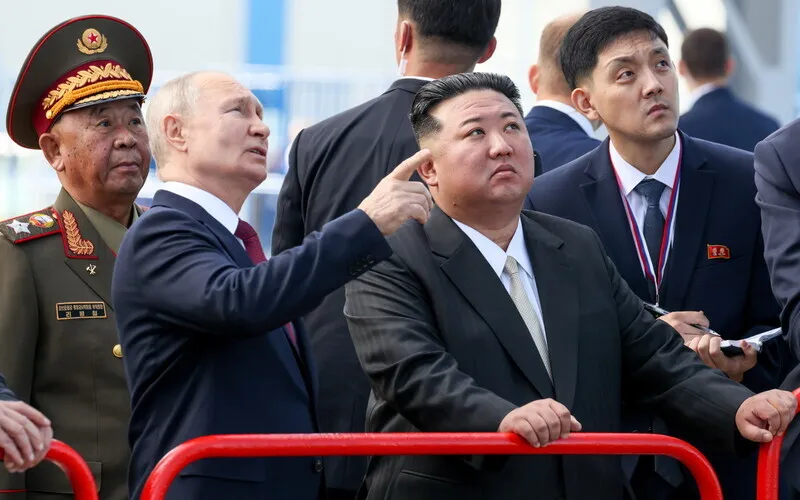hankyoreh
Links to other country sites 다른 나라 사이트 링크
N. Korea may have Russia to thank for ostensible success at placing satellite in orbit

While the North Korean military claims that it had successfully launched its Malligyong-1 military reconnaissance satellite on Tuesday, the South Korean military said that even though the satellite appeared to have entered orbit, it would take time to determine whether it was operating normally.
Experts speculate that North Korea’s launch of the satellite, which took place three months after a second failed launch, may have come with Russia’s help.
North Korea’s state-run Rodong Sinmun newspaper reported that “the carrier rocket ‘Chollima-1’ flew normally along the preset flight track and accurately put the reconnaissance satellite ‘Malligyong-1’ on its orbit,” but did not disclose specific details, such as the inclination angle of the satellite as it went into orbit.
North Korea’s targeted orbit is said to be a low Earth orbit, about 500 kilometers above the planet’s surface.
While South Korea’s Joint Chiefs of Staff said on Wednesday that they had “assessed the North Korean reconnaissance satellite as having entered orbit,” they qualified this by adding that further analysis is needed by relevant agencies under coordination between the US and South Korea in order to determine whether the satellite is functioning properly.
“While North Korea has called the launch a success, the satellite will need to orbit a few times before we can confirm it to have entered and orbited correctly,” a military official commented.
Experts are generally in agreement that, unlike the previous two failed launches, this time around the satellite successfully separated from its launch vehicle and entered its target orbit. In the first launch on May 31 of this year, the satellite separated from the first-stage propellant, but a second-stage engine malfunction caused it to splash down into the waters west of Korea.
In a second launch attempt in August, the first, second and third stages all worked properly, but the satellite deviated from the expected flight trajectory, triggering its emergency explosive device.
“North Korea already successfully launched satellites into orbit in a straight trajectory from Tongchang in 2012 and 2016,” commented Kwon Yong-soo, a former professor at the Korea National Defense University. “This year, the satellites took a sharp turn as they headed in the direction of China, which makes it seem that they have gradually improved their technology to reach the target orbit.”
North Korea may have Russia to thank for this. Since the summit between the two sides at Russia’s Vostochny Cosmodrome in September, there have been speculations that Russia would provide assistance in launching military reconnaissance satellites to North Korea in exchange for Pyongyang exporting artillery shells to Russia.
“The combustion instability and reliability of the two-stage engine that did not work during the first launch is not an easy problem to solve,” said Lee Chun-geun, a senior research fellow at the Science and Technology Policy Institute. “We need to take into consideration whether Russia gave technical advice, provided parts, or supplied them with the entire engine.”
The day before, a South Korean military official told reporters that “circumstantial evidence shows that Russian technicians entered [North Korea] after the North Korea-Russia summit.”
By Jang Ye-ji, staff reporter
Please direct questions or comments to [english@hani.co.kr]

Editorial・opinion
![[Column] Putting the ‘demos’ back in democracy [Column] Putting the ‘demos’ back in democracy](https://flexible.img.hani.co.kr/flexible/normal/500/300/imgdb/original/2025/1112/4417629374603509.jpg) [Column] Putting the ‘demos’ back in democracy
[Column] Putting the ‘demos’ back in democracy![[Editorial] Prosecutors’ selective outrage is self-incriminating [Editorial] Prosecutors’ selective outrage is self-incriminating](https://flexible.img.hani.co.kr/flexible/normal/500/300/imgdb/original/2025/1111/4617628490924276.jpg) [Editorial] Prosecutors’ selective outrage is self-incriminating
[Editorial] Prosecutors’ selective outrage is self-incriminating- [Column] Korea’s ‘republic of lawyers’ is only making things worse
- [Column] Trump should win Nobel War Prize
- [Editorial] Boozing, luxe gifts, playing royalty: Yoon and Kim must pay for privatizing power
- [Column] Korea’s young men need liberating too
- [Correspondent’s column] Yet another fragmented Sado mine memorial
- [Column] Why is South Korea clamoring for yesterday’s nuclear submarines?
- [Column] The banality of Korea’s ‘democratic fascism’
- [Editorial] New York City elects a potent foil to Trump
Most viewed articles
- 1Trump-Kim meeting would be ‘even riskier today,’ warns architect of Agreed Framework
- 2Lee orders crackdown on hate speech, including legal framework for punishment
- 3Korean government seeks to identify public servants involved in martial law crisis
- 4Yoon sent drones to North Korea to stoke conflict and justify martial law, special counsel alleges
- 5How the story of Chol Soo Lee, who united Asian Americans in fight for justice, was forgotten
- 6Former chief of South Korea’s spy agency arrested in insurrection probe
- 7‘No specific purpose’: Experts on how Big Tech attempts to create demand for AI
- 8[Column] Putting the ‘demos’ back in democracy
- 9China is finding solutions to climate crisis for everyone, says COP30 president
- 10‘Very proud’: Korea’s president congratulates T1 on LoL Worlds win three-peat